A Snapshot of Autism Spectrum Disorder in Wisconsin
‹View Table of Contents
Download and print this page [PDF – 151 KB, Print Only]
Findings from the Wisconsin Surveillance of Autism and Other Developmental Disabilities System (WISADDS) help understanding about the number of children with autism spectrum disorder (ASD), the characteristics of those children, and the age at which they are evaluated and diagnosed.
![]() SITE TRACKING AREA
SITE TRACKING AREA
Or 2.8% of 8-year-old children were identified with ASD in WISADDS in 2020.
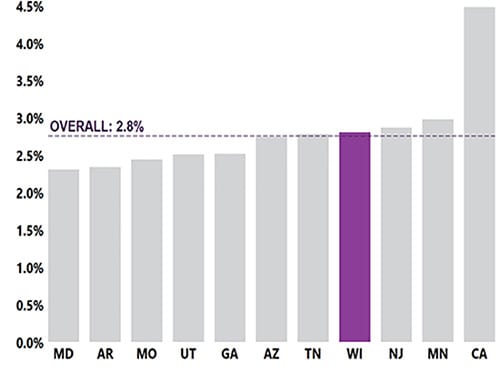
This percentage is higher than it was in 2018 (1.9%) and similar to the overall average percent identified with ASD (2.8%) in all communities where CDC tracked ASD among 8-year-olds in 2020.
or 2.3% of 4-year-old children were identified with ASD in WISADDS in 2020.
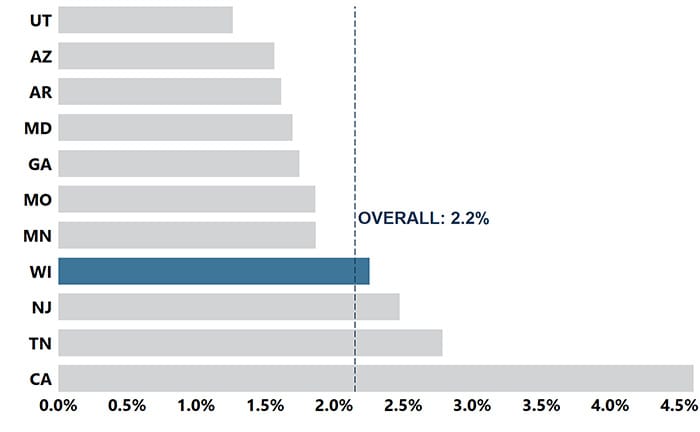
This percentage is similar to the overall average percent identified with ASD (2.2%) in all communities tracked by the CDC.
Hispanic Children were 1.4 times as likely to be identified with ASD as White children. Hispanic 8-year-old children were also 1.4 times as likely to be identified with ASD as Black children.
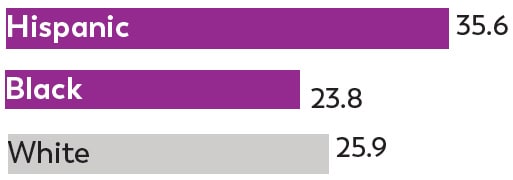
Values indicate prevalence per 1,000 children
Black, Hispanic, and Asian Pacific Islander (A/PI) children were respectively 1.7 times, 2.2 times, and 1.4 times as likely to be identified with ASD as White children.
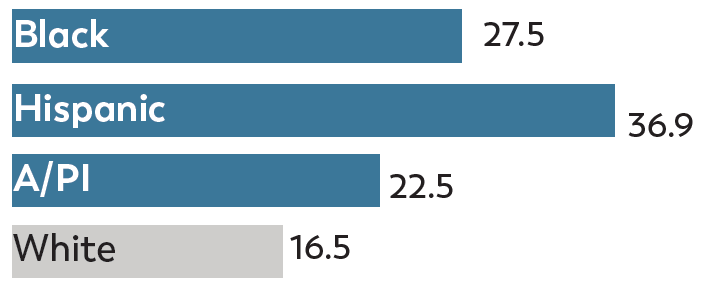
Values indicate prevalence per 1,000 children
More likely to be identified with ASD than girls among both 4-year-old and 8-year-old children.

Among 8-year-old children with ASD, more than half (58%) received a comprehensive developmental evaluation by age 3 years.

Children who were born in 2014 (1.36%) were 2.1x as likely to receive an ASD diagnosis or ASD special education classification by 48 months of age compared to children born in 2010 (0.66%).
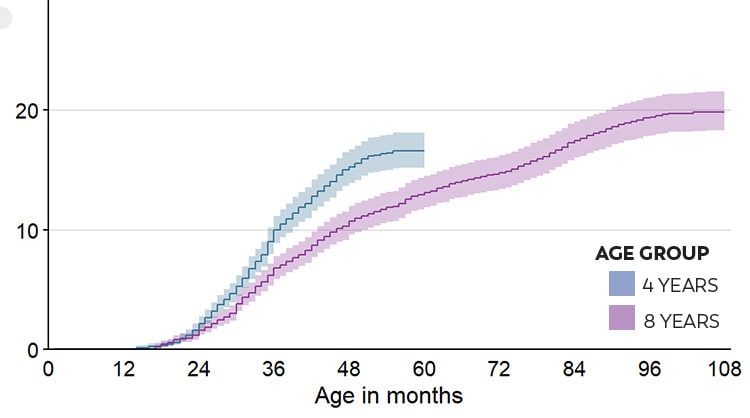
Cumulative incidence of ASD identified per 1000 children
What are the key take-away messages in WISADDS data?
- The percentage of 8-year-old children identified with ASD increased in southeastern Wisconsin, from 1.9% in 2018 to 2.8% in 2020.
- Among both 4-year-old and 8-year-old children, boys were more likely to be identified with ASD than girls.
- 57.5% of 8-year-old children identified with ASD received a comprehensive developmental evaluation by age 36 months, an increase from 2018.
- The prevalence of ASD has varied across racial and ethnic groups since 2002 in WISADDS. In 2020, the prevalence among 4-year-old Hispanic children was higher than any other group. The overall prevalence has increased more for Black, Hispanic, and Asian/Pacific Islanders than for White children.
How can this information be useful?
WISADDS’ latest findings can be used to:
- Promote early identification of ASD.
- Plan for ASD services and training.
- Guide future ASD research, such as research to better understand prevalence differences across all racial and ethnic groups.
- Inform policies promoting access to health care and education for individuals with ASD and improved outcomes over the life course.
Partners in Wisconsin might consider different ways to:
- Increase awareness of developmental monitoring and empower parents to act when there is a concern about their child’s development.
- Lower the age of first evaluation by community providers.
- Increase awareness of ASD and identify and address barriers to early evaluations and services.
How and where was this information collected?
WISADDS uses a record review method. Specifically, this information is based on the analysis of data collected from the health and special education records of 4-year-old and 8-year-old children living in one of eight counties in southeastern Wisconsin in 2020.
Tracking area
Dane, Green, Jefferson, Milwaukee, Ozaukee, Rock, Walworth, and Waukesha counties
8-year-old children in tracking area: 28,789
- 55% White
- 17% Black
- 17% Hispanic
- 6% Asian or Pacific Islander
- .3% American Indian or Alaska Native
- 5% Multiracial
4-year-old children in tracking area: 28,852
- 54% White
- 18% Black
- 17% Hispanic
- 6% Asian or Pacific Islander
- 0% American Indian or Alaska Native
- 5% Multiracial
*Estimates may not sum to 100% due to rounding.
What else does WISADDS do besides tracking ASD among 4- and 8-year-olds?
WISADDS collaborates with partners in Wisconsin to raise awareness about the number and characteristics of children with ASD. This information is useful for planning to meet the growing demand for autism services in our community. In addition to 8-year-olds and 4-year-olds, WISADDS conducts follow-up of outcomes at age 16. WISADDS is also engaged in training and dissemination of information related to developmental disabilities for professionals.
“This report underscores the importance of autism in our community. For the past 50 years, Waisman Center researchers, clinicians, educators and community partners have worked to advance our understanding of autism and other developmental disabilities and to improve outcomes over the life course for individuals and families in Wisconsin. During this time, we have seen steady increases in the number of children on the autism spectrum and the need for services. We are grateful to be a part of the ADDM Network and to have this information on the prevalence of autism in our population and across the nation”.
– QIANG CHANG, PhD
Professor of Medical Genetics and Neurology, Director, Waisman Center, University Of Wisconsin-Madison
Resources
AUTISM SOCIETY OF WISCONSIN
Information and support for families/providers
1-888-4-AUTISM
www.asw4autism.org
BIRTH TO THREE PROGRAM, WISCONSIN DEPARTMENT OF HEALTH SERVICES
Services for children under the age of 3 years with developmental delays or disabilities
www.dhs.wisconsin.gov/birthto3/index.htm
FINDING YOUR WAY
Guide for Wisconsin families who have children and youth with special needs and disabilities
https://ucedd.waisman.wisc.edu/fyw/
CDC’S LEARN THE SIGNS. ACT EARLY.
Resources for families and professionals on child development and what to do if there is a concern
Kris Barnekow
Wisconsin’s Act Early Ambassador
https://www.cdc.gov/ncbddd/actearly/ambassadors-list.html
WELL BADGER RESOURCE CENTER
Information and referral hotline for families/providers working with children and youth with special needs:
Maternal and Child Health and First Step Resource line
800-642-7837
https://www.dhs.wisconsin.gov/mch/well-badger.htm
CONNECT WITH WISADDS
Maureen Durkin, PhD, DrPH
University of Wisconsin-Madison Waisman Center
1500 Highland Ave, Room s101E
608-263-7507
mdurkin@wisc.edu
Pages in this Report
- 2023 Community Report on Autism
- Executive Summary
- Key Findings from the ADDM Network
- A Deeper Dive
- Spotlight On: Progress in Early Identification Disrupted during the COVID-19 Pandemic
- Spotlight On: A New Pattern in Racial and Ethnic Differences
- Data for Action
- ADDM Network Site Snapshots Overview
- A Snapshot of Autism Spectrum Disorder in Arizona
- A Snapshot of Autism Spectrum Disorder in Arkansas
- A Snapshot of Autism Spectrum Disorder in California
- A Snapshot of Autism Spectrum Disorder in Georgia
- A Snapshot of Autism Spectrum Disorder in Maryland
- A Snapshot of Autism Spectrum Disorder in Minnesota
- A Snapshot of Autism Spectrum Disorder in Missouri
- A Snapshot of Autism Spectrum Disorder in New Jersey
- A Snapshot of Autism Spectrum Disorder in Tennessee
- A Snapshot of Autism Spectrum Disorder in Utah
- ›A Snapshot of Autism Spectrum Disorder in Wisconsin
- Glossary
- References